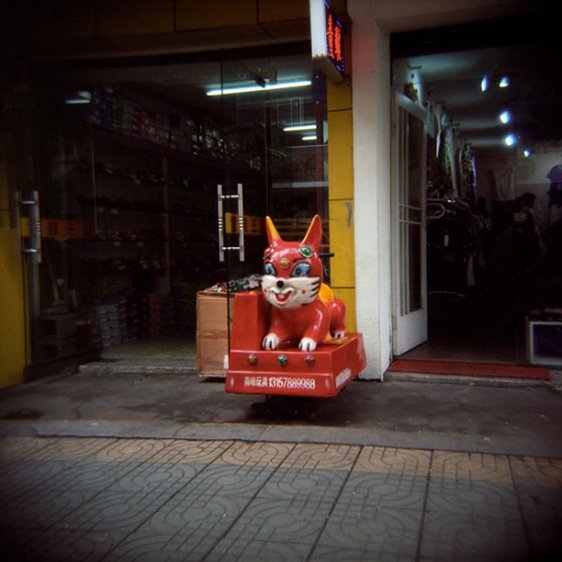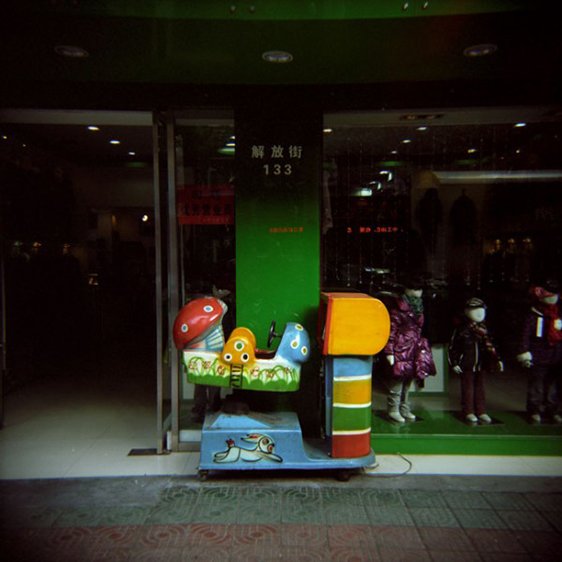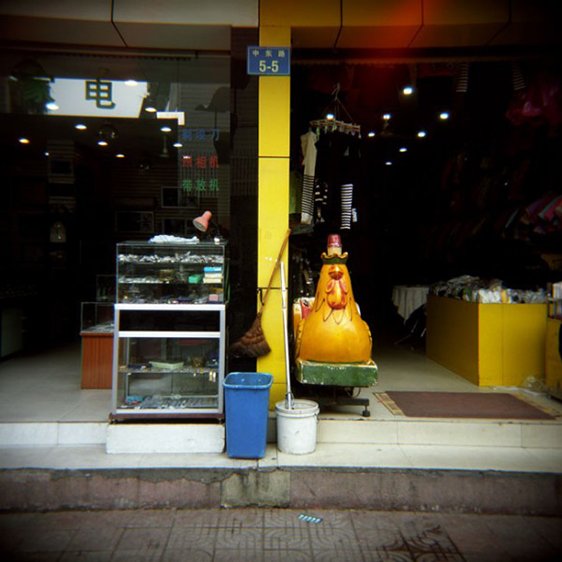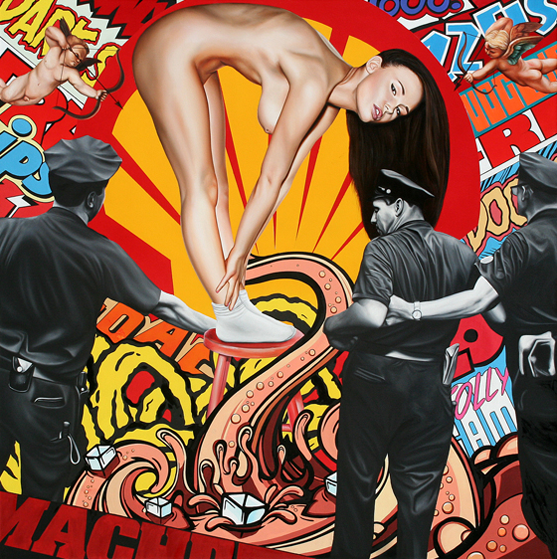U.S.A. –
American artist Ernie Button finds the human element in deserted places. His photographs capture a sense of nostalgia for times past and reveal how time renders certain things useless. Emaho caught up with this extensive traveler and story teller to find out more about his subjects.
Emaho : What got you interested in shooting medium format photography?
I’ve taken pictures and been interested in photography since my teenage years. But until my wife went to grad school to get her MFA in fine art painting, I really didn’t know that there was this whole world devoted to the making and creation, as well as exhibition of art. The art world fascinated me and I wanted to be a part of it, even in a very small way. I took some classes at a local community college to give me a foundation in the basics of photography. After that, I was off and running.

Buckets and Bird
Emaho : Your cereal landscapes are both humorous and intriguing in the way they redefine the viewer’s sense of space. Why chose cereal as a subject?
Art is usually shaped by a person’s life experiences and I am no different. I grew up in the 1970’s and when I was a youngster, cereal was a luxury item. A brand name cereal was a rarity in our house as they were consistently more expensive. Something like King Vitamin, a popular 70’s cereal, or Cap’n Crunch made for pure breakfast heaven as a child. On a trip to the grocery store when I was an adult, I saw a box of King Vitamin next to a new version of Cap’n Crunch, Choco Donuts. Looking at the rest of the cereal aisle, it became very clear that breakfast cereal had changed from nutrition to entertainment.
It was a project that evolved naturally for me, starting with just a few experimental portraits of cereal leading to the building of the more complex constructed landscape dioramas. From a photography perspective, cereal was a visual cornucopia of vibrantly colored marshmallows that resemble people and objects and characters from movies, as if they were calling out to have their portraits taken, to be the center of attention. However, on the other side of the aisle sits the more ‘adult’ cereals (i.e. fiber, bran). Having lived in Arizona for over 35 years, those cereals upon close inspection resemble some of the shapes and colors and textures of the southwestern desert. I began to construct landscapes that would utilize the natural earth tones of certain cereals. I placed enlarged photographs of actual Arizona skies in the background of the cereal landscapes giving the final image an odd sense of reality. It is apparent that cereal is not just for breakfast anymore. Cereal has evolved into pop culture objects instead of just nutritious corn pops.

Dale
Emaho : Many of your images do not have people in them, yet they don’t feel like empty or abandoned spaces. Rather, there’s a figurative element to the inanimate objects, buildings, and landscapes in your work. Do you feel your subjects have charisma, even without necessarily being humans?
Besides just pure, untouched nature, everything else that we encounter has a touch or influence of mankind. So even though I am not taking direct images of people, I am taking what they have left behind, how they have impacted or influenced an environment.

Fire Cat
Emaho : Is there a narrative element to your work?
There is a narrative quality to some of my work in that I am trying to visually support a particular theory or artist’s statement of mine. For example, the portfolio Back and Forth was trying to visually tell the story of how the coin-operated grocery store ride was disappearing from the urban landscape which happened to coincide with the economic collapse in the late 2000’s. But a lot of my travel photography is more objective in that I’m trying to visually arrange the elements in the frame to make a well-composed, visually interesting, thought provoking image.

Mushroom Ride
Emaho : Many of your photos have vignettes, giving off a sense of nostalgia or memory. Does time play a role in your work?
Yes, several of my portfolios only occurred because of the recognition that time has passed and changed the meaning to me or changed the physical structure of the object. With Back and Forth, it was the fond recollection of these rides from when I was a child. When the rides started to disappear, I felt that I needed to document that. With Cerealism, it was a cereal that I grew up with, King Vitamin from the 1970’s that I recognized on a trip to the grocery store that got me looking around at the cereal aisle. Portraits in Plastic are portraits of the actual toys that I grew up with.
Clearing the Land was the documentation of “progress”, the clearing of these beautiful old palm trees to make way for new houses. However, the housing market bubble burst and the palm trees were gone; there were no houses to be built leaving these flat, unattractive patches of dirt.

Rooster
Emaho : There is such richness in your art work when you are shooting across the world. What do you find is different about photography while travelling than working on subjects at home?
My photography has developed a consistency or a style i.e. there are subject matters that I tend to consistently photograph as well as how I frame up a photograph. But traveling gives me the exposure to new environments and subject matter. I live in Arizona where there is wonderful light and landscape throughout the state. It’s a beautiful state in large part due to its diverse landscape, from the Grand Canyon to the Red Rocks of Sedona to the Sonoran Desert. Some of photography’s greats have spent time photographing Arizona, including Ansel Adams and Mark Klett. A magazine like Arizona Highways does an excellent job of introducing someone to this landscape. But being exposed to new environments and culture pushes my photography out of its comfort zone. My travels to China are a perfect example of getting out of that comfort zone, ultimately improving my photography.

Say Hey Cats
Emaho : Could you share a memorable story about any of the places you’ve captured?
In 2009, I was invited to exhibit work from Cerealism at the Lishui International Photography Festival in Lishui, China. The people were welcoming, generous and seemed to truly appreciate that I had come to share my photography at the festival. After attending the festival’s opening ceremonies and the multiple exhibits around the city, I had an opportunity to explore. Armed with my Holga cameras, I set off to explore the city of Lishui and the surrounding landscape.

Ultraman 2012
During a previous photographic series, Back and Forth, I postulated that the coin-operated ride was disappearing from the urban landscape in the States, specifically Phoenix, Arizona where I live. What I found here in Lishui was just the opposite; a plethora of coin-operated kiddie rides dotting the urban landscape. The rides were flourishing, lining most of the streets that I ventured down. I’ve seen a fair amount of China and in my travels, I have seen a few rides in various Chinese cities, but nothing like what I saw in Lishui. I would openly (and jokingly) wonder if they were all being shipped from the USA right into Lishui, except that is obvious that the rides are constructed of very different character and animals than what I’ve seen in the US.
I returned to Lishui in 2012 with the intent of taking more images of the coin-operated rides. Thankfully, many rides remained allowing me further opportunities to document them. What became evident, the more miles I logged walking around the city, is that the rides were a disconnected calling card for the micro-businesses that appeared behind the roll-up garage doors that were their storefronts. However, just like in the United States, I rarely saw anyone on the rides; they become more of an entertaining fixture of the storefront. I’m not sure what, if anything, the large number of coin-operated rides is saying about the city of Lishui, or what it says about our society vs. theirs, but it was such a pleasant surprise seeing them after having spent the past decade documenting their disappearance from America’s urban landscape.

Up and Down Duck
Art & Culture Interviewed by Hemanshi Jain
Photographs by Ernie Button














